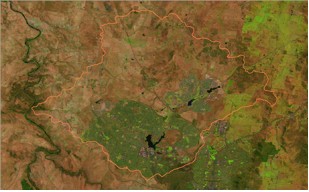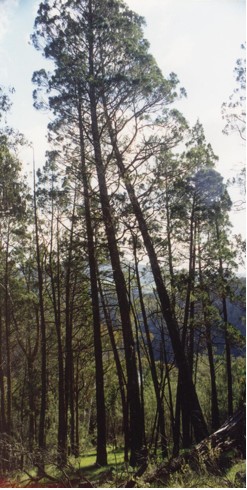As Landcarers, the plants that we use can be thought of not only as a delight within themselves, but also a tool kit that we can use to help maintain and improve ecosystem values, levels of erosion, rates of waterflow and so on. What has existed in the landscape often provides a good indication of what is possible however often we are dealing with landscapes so changed that we have to look to other species for options. Still you will more often find locals fit for the job at hand.
Our catchment has seen many plantings of varying success. We can learn from what has been tried in the past to guide us as to the best use of our resources now. Frost, drought, weed competition, high water levels and so on have all served to show us more about the nature of the land on which we work.
As part of this project I am beginning a species list for our catchment that members can contribute their own knowledge to. I am looking at indigenous species as we have a huge diversity here to draw on. However to know what existed in any particular area, you have to look at which species in this list existed in the ecotype that was present. We should not however restrict ourselves too much. The country we are dealing with is very altered and we cannot hope to get it back to anything like a pristine state.
The Society for Growing Australian Plants Wednesday Walk lists are very informative. They are provided with this kit of resources. Friends of Aranda Bushland’s “Our Patch” is also very good and though just outside our Catchment for the most part, these plant communities once did extend into the Ginninderra Catchment even if they are not still there now. I have an aerial photo of the suburb of Aranda in the 1960’s and it does show the bushland was very good.
There is a lot to add to this list. I am doing as much as I can during the writing of this report but it is a job that will be far from complete.
Trees
Acacia dealbata (Silver Wattle)
Acacia mearnsii (Black Wattle)
Acacia melanoxylon
(Blackwood)
Acacia parramattensis
(Parramatta Wattle)
Acacia pravissima
(Ovens Wattle)
Acacia implexa
(Hickory Wattle)
Acacia rubida
(Red Leaf Wattle – Dry them
and see!)
Allocasuarina verticillata
(Droopin She Oak)
Callitris endlicheri
(Black Cypress Pine)
Casuarina cunninghamiana
(River Oak – Natural stands at
Ginninderra Falls)
Eucalyptus blakelyi
(Blakely’s Red Gum)
Eucalyptus bridgesiana
(Apple Box)
Eucalyptus dives
(Broad Leaved Peppermint)
Eucalyptus goniocalyx (Bundy)
Eucalyptus nortonii (Mealy Bundy)
Eucalyptus macrorhyncha
(Red Stringybark)
Eucalyptus mannifera (Brittle Gum)
Eucalyptus melliodora (Yellow Box)
Eucalyptus polyanthemos (Red Box)
Eucalyptus rossii (Scribbly Gum)
Eucalyptus rubida (Candlebark)
Eucalyptus viminalis (Manna Gum)
Exocarpus cupressiformis (Native Cherri)
Shrubs
Acacia genistifolia (Early Wattle)
Acacia gunnii (Ploughshare Wattle)
Acacia lanigera (Box Leaved Wattle)
Bursaria spinosa (Sweet Bursaria)
Cassinia aculeata (Dolly Bush)
Cassinia longifolia (Shiny Cassinia)
Cassinia quinquefaria
Daviesia mimosoides (Bitter Pea)
Desmodium varians
Dillwynia phylicoides (Parrot Pea)
Dillwynia sericea (Egg and Bacon)
Dodonea viscosa (Hop Bush)
Gompholobium huegelii
Grevillea alpina
Hakea decurrens (Bushy Needlewood)
Hovea linearis
Indigofera adesmiifolia
Indigofera australis (Australian Indigo)
Kunzea ericoides (Burgan)
Kunzea parvifolia (Small Leaved Kunzea)
Leptospermum continentale (Prickly Tea Tree)
Leptospermum multicaule (Silver Tea Tree)
Mirbelia oxylobioides (Mountain Mirbelia)
Persoonia rigida (Rigid Geebung)
Pomaderris angustifolia
Pultenaea procumbens (Egg and Bacon)
Herbaceous/ Forbs
Acaena ovina (Sheep’s Burr)
Bracteantha viscose (Sticky Everlasting)
Calocephalus citreus (Lemon Beautyheads)
Calotis lappulacea (Yellow Burr Daisy)
Chrysosephalum apiculatum (Yellow Buttons/ Common Everlasting)
Chrysosephalum semipapposum (Clustered Everlasting)
Convolvulus erubescens (Australian Bindweed)
Craspedia variabilis (Billy Buttons)
Eryngium ovinum (Blue Devil)
Geranium solanderi (Native Geranium)
Hydrocotyle laxiflora (Sticking Pennywort)
Hypericum granineum (Small Saint John’s Wort – Yes it is a native unlike its weedy cousin!)
Leptorhynchos squamatus (Scaly Buttons)
Microseris lanceolata (Yam Daisy/ Murnong)
Plantago varia (Variable Plantain)
Ranunculus lappaceus (Common Buttercup)
Rumex brownii (Swamp Dock)
Rutidosis leptorhynchoides (Button Wrinklewort – Threatened Species)
Stackhousia monogyna (Creamy Candles)
Stylidium graminifolium (Grass Triggerplant)
Triptilodiscus pygmaeus (Austral Sunray)
Vittadinia muelleri (Narrow Leaf New Holland Daisy)
Vittadinia cuneata (Fuzzy New Holland Daisy)
Wahlenbergia communis (Tufted Bluebell)
Grasses
Austrodanthonia auriculate (Lobed Wallaby Grass)
Austrodanthonia bipartite (Wallaby Grass)
Austrodanthonia carphoides (Short Wallaby Grass)
Austrodanthonia eriantha
Austrodanthonia laevis
Austrostipa bigeniculata (Tall Spear Grass)
Austrostipa densiflora (Dense Spear Grass)
Austrostipa scabra (Cork Screw Spear Grass)
Bothriochloa macra (Redleg Grass)
Chloris truncata (Windmill Grass)
Dichelachne crinita (Plumegrass)
Elymus scaber (Wheatgrass)
Joycea pallida (Red Anther Wallaby Grass)
Microlaena stipoides (Weeping Grass)
Panicum effusum (Hairy Panic)
Poa labillardieri (River Tussock)
Poa sieberiana (Poa Tussock)
Sorghum leiocladum (Wild Sorghum)
Themeda triandra (Kangaroo Grass)
Reeds Rushes and Sedges
Carex appressa (Tall Sedge)
Juncus australis (?)
Juncus holoschoenus
Juncus subsecundus (Rush)
Juncus usitatis (Rush)
Lazula sp. (Woodrush)
Lomandra filiformis (Wattle Mat-rush)
Lomandra longifolia (Spiny Headed Mat-rush)
Phragmites australis (Common Reed)
Typha orientalis (Bulrush)
Lilies
Bulbine bulbosa (Bulbine Lily)
Dianella revoluta (Black Anthered Flax Lily)
Dianella longiflora
Dichopogon fimbriatus (Chocolate Lily)
Thysanotus tuberosus (Common Fringe Lily)
Tricoryne elatior (Yellow Rush Lily)
Wurmbea dioica (Early Nancy)
Further Reading
1. SGAP Wednesday Walk Species Lists provided with this report. (Provided with this report).
2. CA Lamp, SJ Forbes & JW Cade, Grasses of Temperate Australia, Bloomings Books, Melbourne, 2001
3. DJB Wheeler, SWL Jacobs, RDB Whalley, Grasses of New South Wales, University of New England, Armidale NSW, 2002
4. Meredith Mitchell, Native Grasses – An Identification Handbook for Temperate Australia, CSIRO, 2002
5. Friends of Aranda Bushland, Our Patch, Published 1997
6. Leon Costermans, Native Trees and Shrubs of South Eastern Australia, Weldon Publishing, Willoughby NSW, First Published in 1981 with many revised edditions.
7. Sainty & Jacobs, Waterplants in Australia, Sainty and Associates Pty Ltd, Published 2003
Note: All the books above are available at the ANBG bookshop.
